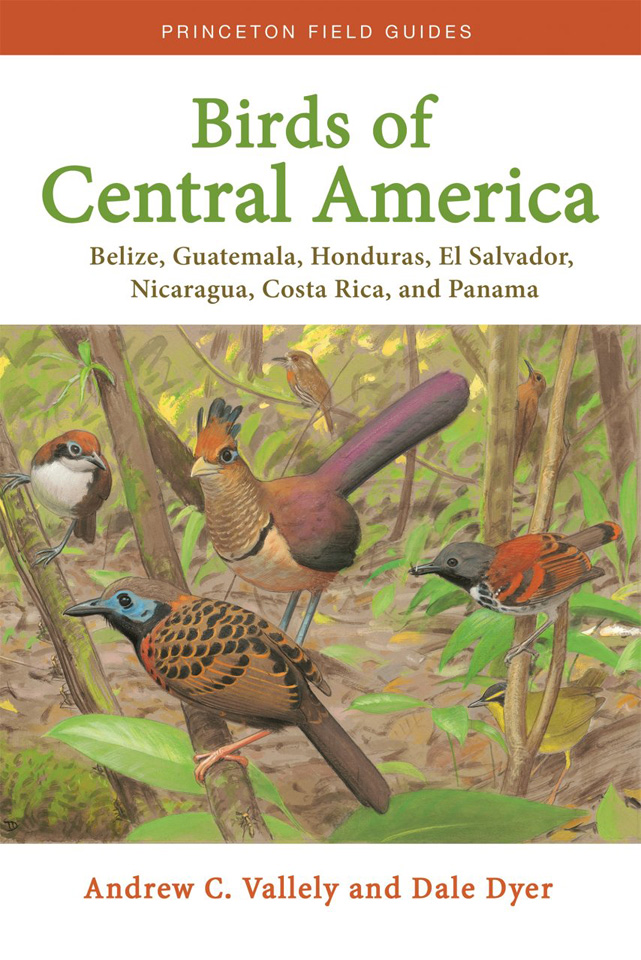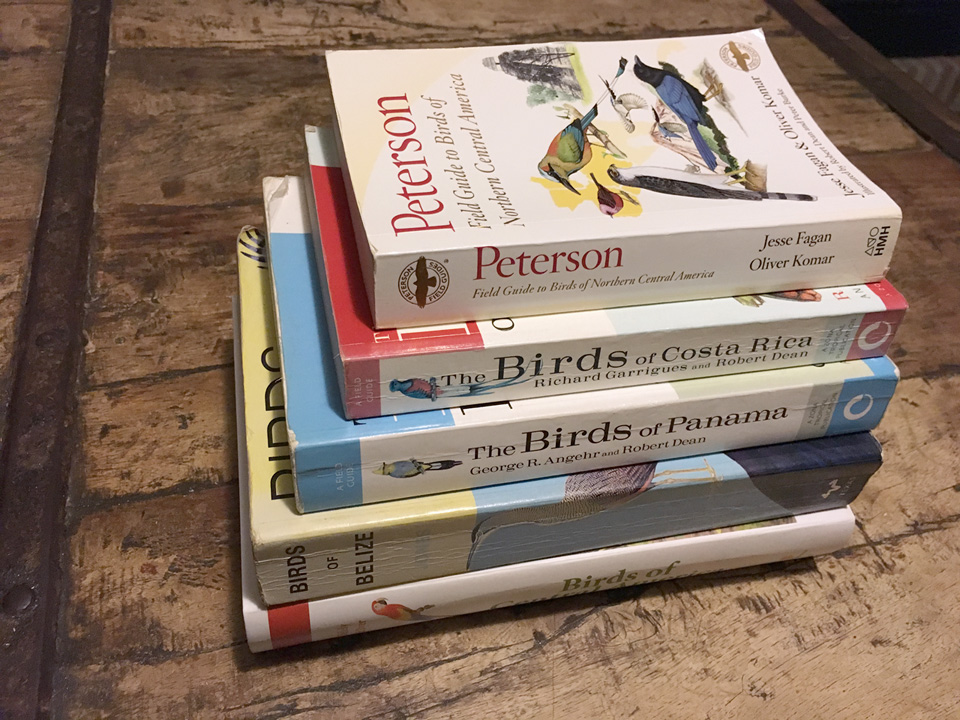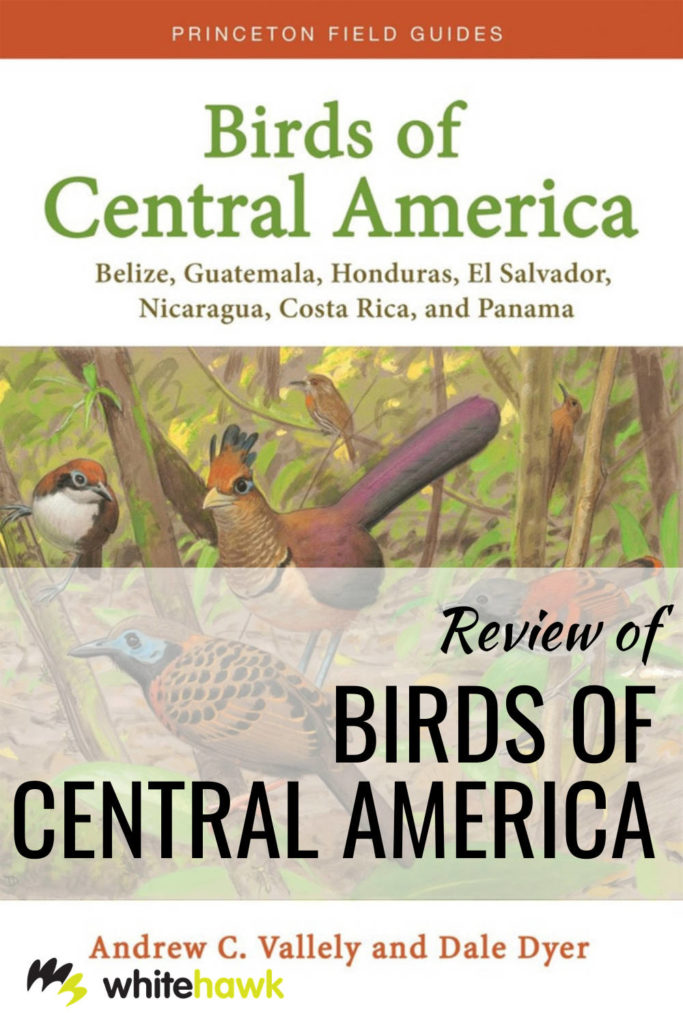On this review of Birds of Central America, we go over the different sections of the book and compare it to other publications that focus on bird identification in the region.

The Authors
This is an impressive book by Andrew C. Vallely and Dale Dyer. It is the first field guide to encompass the entire Central American region, comprising seven countries. Guatemala, Belize, Honduras, El Salvador, Nicaragua, Costa Rica and Panama are all represented. Both authors have traveled and have extensive experience in Central America. Dyer has published numerous illustrations in Neotropical bird guides, such as ‘Birds of Peru’ and ‘Bird Guide of Trinidad and Tobago’. Additionally, both authors work for the Department of Ornithology of the American Museum of Natural History. This has facilitated their prolonged access to a large collection of specimens and has facilitated contact with many other collections.
The authors’ experiences have served this book well. Its main section, ‘Birds of Central America’ covers 1,194 bird species in great detail. It includes concise texts on identification and behavior, distribution maps and illustrations. It also includes 67 additional species, of which there are only some citations, in an annex.
Other field guides for the region
The fact that this book covers an area as large and diverse as Central America is both a strength and a weakness. There are three other books that have covered parts of this region: ‘A Guide to the Birds of Panama, with Costa Rica, Nicaragua and Honduras’ (Ridgely and Gwinne, 1989), ‘A Guide to the Birds of Mexico and Northern Central America’ (Howell and Webb, 1995) and, more recently, ‘Peterson Field Guide to Birds of Northern Central America’ (Fagan and Comar, 2016). But, there is currently no other book out there that includes all of the species distributed throughout the width and length of the region. This makes the ‘Birds of Central America’ a unique find.
However, it probably isn’t very often that anyone would need one guide for all these countries during a single trip. In fact, the book is quite bulky for a field guide. It weighs 1.4kg and measures 22.86 x 15.24cm. We must consider the size and weight if we want to have the book tucked in our backpack when we climb a muddy hill during a tropical downpour. As for other physical characteristics of the book, the quality of the paper and the flexible cover certainly suggests a resistant, highly durable product.

Introductory section
The book begins with an introduction to Central America. It provides a detailed description of how the book is organized. It explains the different sections included for each of the treated species. Of particular interest is the section that describes the different biogeographic zones of the region.
The main part of the book, as you would expect, includes information related to each species. A small distribution map is found to the left of the text accompanied by a short description. Further details on species identification, habitat, behavior and vocalizations enhance the value of this book. The plates with illustrations corresponding to each species can be found on the opposing page. In some cases, notes on the taxonomy are added, particularly if there have been recent changes. Information on geographical variations is also included.
The texts are precise and concise, especially when describing the identifying characteristics of each species. At times, one would hope for a greater abundance of details, and more comparisons with similar species. In this regard, other guides in the region contain more detailed texts, like the aforementioned Howell & Webb.
The order of the species follows the list of Birds of North America published by the American Ornithology Union in 2017. However, there are some variations that facilitate the comparison of similar birds that, otherwise, may be confusing. A handy feature is the index of the different bird groups listed on the inside flaps of the book. This is of great help when it comes to quickly finding the species that one is looking for.
The illustrations
A highlight of this work is the high quality of the illustrations. These are, for the most part, excellent. They show the birds in their typical postures, with a high degree of fidelity to the expression of the bird as well as meticulous detail of the plumage and bare parts. There are some exceptions however. Illustrations of some groups of birds, such as raptors, shorebirds, and gulls, are not of the same high quality. At other times, it appears that the magnificent illustrator, Dale Dyer, may have been painting from museum specimens and not from observations made of live birds. In some illustrations the birds appear somewhat rigid and unnatural. However, the majority of the illustrations are superb. This is especially meritorious, considering that all them have been made by a single artist, an unusual feat in a guide of this scope.
While the plates are beautifully rendered, at first glance, they appear a bit washed out. This makes the illustrations look too pale. Other readers have commented on this as well. Thus we have ruled out the possibility that it could be just our copy. It is possible, however, that this is an effect sought by the authors. And the truth is, after spending a while contemplating the illustrations in this book, the impression that there is a lack of contrast disappears. And by comparison, the rest of the guides suddenly seem to have an exaggerated contrast, with excessively dark contours and colors that are way too saturated.
In general, the illustrations are generously sized, occupying as much of each page as possible. In the upper right margin of each page, the authors have indicated the proportion of the illustrations with respect to the actual size of the bird. All the species on the same page are in the same proportion. Generally the distribution of illustrations is clear and does not give rise to confusion. Although sometimes a clearer separation would be desirable, as we are used to seeing in guides such as ‘The Sibley Guide to Birds’ by David Sibley, and ’Birds of Europe and North Africa’ by Svensson, Mullarney and Zetterström.
Added Value
The age classes, as well as the different sexes in those species that present sexual dimorphism, are mostly reflected in the illustrations. Also, as mentioned, illustrations of many of the subspecies and geographic variants are frequently shown. This is remarkable since this is the first time many of these variants are represented in an identification guide. This feature allows us to appreciate at a glance the subtle (and sometimes not so subtle) differences between individuals from different populations
Another added value is the inclusion of some relatively recent ‘splits’. For example, the wrens of the genus Cantorchilus (Cabanis’s, Canebrake and Isthmian Wren). These were formerly included in another genus as Plain Wren. Each receives its corresponding illustration which reflect the differences between them. This helps us to better appreciate the variations among these species. Likewise, the maps show how they are distributed with little overlap throughout the region. Another good example is that of Lesson’s Motmot and Whooping Motmot. Until recently, they were considered the same species. But in this book, each one has its corresponding illustration, showing the small differences that will allow us to distinguish between these parapatric species. These and other taxonomic novelties (31) have been included in the Taxonomic Notes, in the final part of the book.
If something is missing from the illustrations, it is the lack of depictions of birds in flight. This is the case for many of the pigeons and thrushes, and some raptor species, which is a pity since, in the field, birds of prey are most often observed in flight. However, this seems to be a detail missing from most field guides, which lack an illustration that shows the top of the bird in flight. Another aspect that would enrich the book further would be the use of arrows, as in the Peterson Identification System (as in the aforementioned Birds of Europe guide), to point out the most relevant identification features that separate similar species, age classes or sex.
Maps and final sections
The distribution maps are fully updated with the available information. They are detailed and include isolated observations of interest, as well as small populations. However, there does appear to be one error. It appears that the maps of Blue-throated Motmot and Turquoise-browed Motmot have been interspersed.
Following the main part of the book comes the section corresponding to those species that have been cited on few occasions in the region or about which it has not been possible to confirm their presence. This section consists of a two-page list of species with a brief description of the records. Below this, are the Taxonomic Notes of those species on which recent changes have been made. It is followed by a brief glossary of terms used during the text and, finally, the extensive bibliography (677 references) and the index.
Conclusion
As mentioned at the beginning, one of the greatest virtues of this guide is also its biggest problem. Covering a region as wide and rich in species as Central America affects the size and weight of the volume. This makes it, perhaps, uninteresting as a guide to take into the field, thus relegating it, in most cases, to a reference book once we are back home.
It is important to keep in mind that most trips made by amateur or professional birders usually take place in a single country at a time, so it may be more convenient to have field books specific to that country. There are several high quality works to choose from including Richard Garrigues’ ‘The Birds of Costa Rica’ (2007) and George R. Angehr’s ‘Birds of Panama’ (2010).
Though it isn’t conveniently taken into the field, so many other aspects of this work make ‘Birds of Central America’ indispensable for anyone with a minimum interest in the birds of the region. The updated taxonomy and maps, the inclusion of illustrations of geographical variants, different age and sex classes, as well as the high quality of the plates, make this guide the prime bibliographic reference on Central American birds. And that’s not a small thing!


